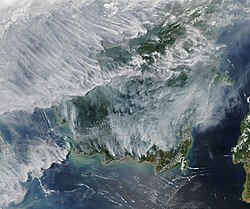| Southeast Asian haze series |
|---|
 |
| History |
| Key topics |
| Responses |
| See also |
|
|
| Southeast Asian haze | |||||||
|---|---|---|---|---|---|---|---|
| Chinese name | |||||||
| Traditional Chinese | 東南亞霾害 | ||||||
| Simplified Chinese | 东南亚霾害 | ||||||
| |||||||
| Vietnamese name | |||||||
| Vietnamese | Sương mù Đông Nam Á | ||||||
| Thai name | |||||||
| Thai | ฝุ่นควันในเอเชียตะวันออกเฉียงใต้ | ||||||
| RTGS | fun khwan nai echia tawanok Chiang Tai | ||||||
| Malay name | |||||||
| Malay | Jerebu Asia Tenggara | ||||||
| Indonesian name | |||||||
| Indonesian | Polusi asap Asia Tenggara | ||||||

The Southeast Asian haze is a fire-related recurrent transboundary air pollution issue. Haze events, where air quality reaches hazardous levels due to high concentrations of airborne particulate matter from burning biomass,[1] have caused adverse health, environmental and economic impacts in several countries in Southeast Asia.[2][3] Caused primarily by slash-and-burn land clearing, the problem flares up every dry season to varying degrees[4] and generally is worst between July and October and during El Niño events.[5] Transboundary haze in Southeast Asia has been recorded since 1972[6] with the 1997 and 2015 events being particularly severe.[7]
Industrial-scale slash-and-burn practices to clear land for agricultural purposes are a major cause of the haze, particularly for palm oil and pulpwood production in the region. Burning land occurs as it is cheaper and faster compared to cutting and clearing using excavators or other machinery.[8][9][10] Fires started for this purpose sometimes spread and create forest fires, worsening the problem. The high concentration of peat in soil contributes to the haze's density and high sulphur content.
Fires in Indonesia (particularly South Sumatra and Riau in Sumatra, and Kalimantan in Borneo), and to a lesser extent in Malaysia and Thailand, have been identified as sources. The haze regularly has a major impact on air quality in Indonesia, Malaysia, Singapore and Brunei Darussalam; to a lesser extent and in particularly severe years, it also impacts the Philippines, Thailand, Vietnam, Cambodia and countries outside the region.[3]
Haze events have been shown to cause health issues and mortality in affected areas, and have caused disruption to economic activity and education as sectors are forced to close to minimise exposure to hazardous air. The haze also has a substantial environmental impact, being a major contributor to greenhouse gas emissions in the region and affecting wildlife and ecosystems.
The haze is an international issue which has caused regional political tensions. Efforts have been made to mitigate haze events and their impacts, and some relevant frameworks for regional cooperation among ASEAN countries have been introduced. Challenges remain in implementing these, and mitigation efforts have failed to prevent haze from reoccurring.
- ^ Karthik, K R G (10 August 2017). "Understanding the Southeast Asian haze". Environmental Research. 12 (8): 084018. Bibcode:2017ERL....12h4018G. doi:10.1088/1748-9326/aa75d5. hdl:10356/107014.
- ^ "Regional Haze Action Plan". ASEAN.org. Haze Action Online. Archived from the original on 5 December 2013. Retrieved 23 February 2014.
- ^ a b Ramakreshnan, Logaraj; Aghamohammadi, Nasrin; Fong, Chng Saun; Awang, Bulgiba; Ahmad Zaki, Rafdzah; Wong, Li Ping; Sulaiman, Nik Meriam (5 December 2017). "Haze and health impacts in ASEAN countries: a systematic review". Environmental Science and Pollution Research. 25 (3): 2096–2111. doi:10.1007/s11356-017-0860-y. ISSN 1614-7499. PMID 29209970. S2CID 24828821.
- ^ "Why is South-East Asia's annual haze so hard to deal with?". The Economist. 7 July 2013. Retrieved 28 June 2014.
- ^ "What causes South East Asia's haze?". BBC. 16 September 2019. Retrieved 30 September 2019.
- ^ Lee, Min Kok (2 October 2015). "Haze in Singapore: A problem dating back 40 years". The Straits Times. Archived from the original on 2 October 2015. Retrieved 3 October 2015.
- ^ Tacconi, Luca (6 July 2016). "Preventing fires and haze in Southeast Asia". Nature Climate Change. 6 (7): 640–643. Bibcode:2016NatCC...6..640T. doi:10.1038/nclimate3008. ISSN 1758-6798.
- ^ Soeriaatmadja, Wahyudi (12 October 2015). "Minister blasts execs of firm that denied burning forest". The Straits Times. Archived from the original on 13 October 2015. Retrieved 13 October 2015.
- ^ Fogarty, David (27 September 2015). "Lucrative illegal market for crop land a key cause of fires: Researcher". The Straits Times. Archived from the original on 28 September 2015. Retrieved 27 September 2015.
- ^ Mayberry, Kate. "Southeast Asia struggles to tackle haze despite long-term dangers". www.aljazeera.com. Retrieved 23 November 2021.